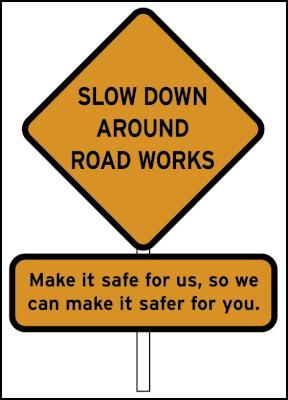Drivers Heeding Slow Down Campaign
7 April 2006
Drivers Heeding Slow Down
Campaign

As a result of the “Slow Down Around Road Works” campaign, 85 percent of people recently surveyed by AC Nielsen said they were more likely to slow down.
And anecdotal evidence from road workers and police supports a definite change for the better in driver behaviour since the campaign has been running over the past two summers.
The campaign was developed by a joint team of Glenda Hughes and Robertson Communications. They believe its success hinges on the fact it takes a different approach to the usual hard-hitting road safety advertising.
“Changing people’s behaviour, especially that of New Zealand drivers, is extremely hard,” says campaign co-ordinator, Glenda Hughes. “Our social marketing research strongly suggests that if people are not prone to behave as you want them to, if there’s resistance to change, then your communications will work better if you use an approach that ‘sells’ rather than ‘tells’.”
David Robertson, creative director of Robertson Communications, says, “We didn’t want the creative to bludgeon people with the message. We reminded them that road workers are there to make the roads safer for drivers, so we asked drivers in return to make it safer for the workers. And we believe the fact we asked for people’s help, rather than ordered them to change their behaviour, has made all the difference.”
The campaign effort began when Hughes was approached by the management of WORKS Infrastracture, which employs road workers. In 2003, as many as seventeen drivers and passengers lost their lives around road works*. Road workers were becoming demoralised and in some cases, traumatised, so their employer wanted to do something about it.
“WORKS’ problem was that they did not have the budget to do the kind of campaign that would achieve the exposure they needed to make real change in driver behaviour,” says Hughes. “So they asked me to find support from other relevant stakeholders, such as ACC and Roading New Zealand, which I did. And the final funding was provided through the Road Safety Trust.”
The campaign, created by Robertson Communications, was developed at two levels – one, a series of commercials aimed at the driving public, and two, an information campaign for any organisation involved with road works, including the local councils, the police, and road workers themselves.
“It was vital that everyone – from central Government on down to individual road workers – knew what the campaign was about and was fully behind it,” says Hughes. “We considered it so important, we launched it at Parliament. ”The then Minister of Transport, Harry Duynhoven, said it was the first occasion when there’d been co-operation across the board between all the industry stakeholders.”
The campaign won the outstanding community safety/injury prevention coalition award at the inaugural New Zealand Community Safety and Injury Prevention Awards, 2005.
ENDS


 Bill Bennett: Download Weekly - Review Of 2024
Bill Bennett: Download Weekly - Review Of 2024 Bill Bennett: One NZ scores worldwide first as Starlink direct-to-mobile launches
Bill Bennett: One NZ scores worldwide first as Starlink direct-to-mobile launches Hugh Grant: How To Reduce Network Bottlenecks
Hugh Grant: How To Reduce Network Bottlenecks Dominion Road Business Association: Auckland Transport's 'Bus To The Mall' Campaign: A Misuse Of Public Funds And A Blow To Local Businesses
Dominion Road Business Association: Auckland Transport's 'Bus To The Mall' Campaign: A Misuse Of Public Funds And A Blow To Local Businesses Parrot Analytics: A Very Parrot Analytics Christmas, 2024 Edition
Parrot Analytics: A Very Parrot Analytics Christmas, 2024 Edition Financial Markets Authority: Individual Pleads Guilty To Insider Trading Charges
Financial Markets Authority: Individual Pleads Guilty To Insider Trading Charges



